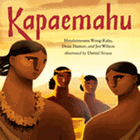
Kapaemahu began as an animated short film. The award-winning production team of Hinaleimoana Wong-Kalu, Dean Hamer and Joe Wilson now sets their script onto the page, resulting in a spectacular picture book featuring stills from animation director Daniel Sousa's moving images.
"Long ago," four Tahitians settled in Waikiki. "The visitors were tall and deep in voice yet gentle and soft-spoken." Most importantly, "They were not male; they were not female. They were mahu--a mixture of both in mind, heart, and spirit." Their leader was the titular Kapaemahu; each member of the quartet was skilled "in the science of healing." The people erected a monument of "four great boulders" into which "the healers began to transfer their powers," then the mahu disappeared. Eventually, "everything changed." Wordlessly, Sousa shows how Christianity took hold, foreign soldiers took charge, progress eventually brought high-rises and tourists--"the stones of Kapaemahu were forgotten." The stones were finally recovered, but "the fact that the healers were mahu has been erased."
The book, like the film, is bilingual, with the film's Olelo Niihau language ("the only form of Hawaiian that has been continuously spoken since prior to the arrival of foreigners") followed by an English translation. Wong-Kalu is "Kanaka--a native person descended from the original inhabitants of the islands of Hawaii," and "also mahu, which like many Indigenous third-gender identities, was once respected but is now more often a target for hatred and discrimination." Sousa's full-page bleeds and saturated palette of predominantly deep earth colors display potent images. Light heightens Sousa's superb imagery: glowing golds underscore gentle strength; soft, wispy white captures healing energy. Power continues to flow through transparent prose and magnificent visuals, gifting audiences with insights celebrating acceptance and inspiring strength. --Terry Hong, Smithsonian BookDragon

